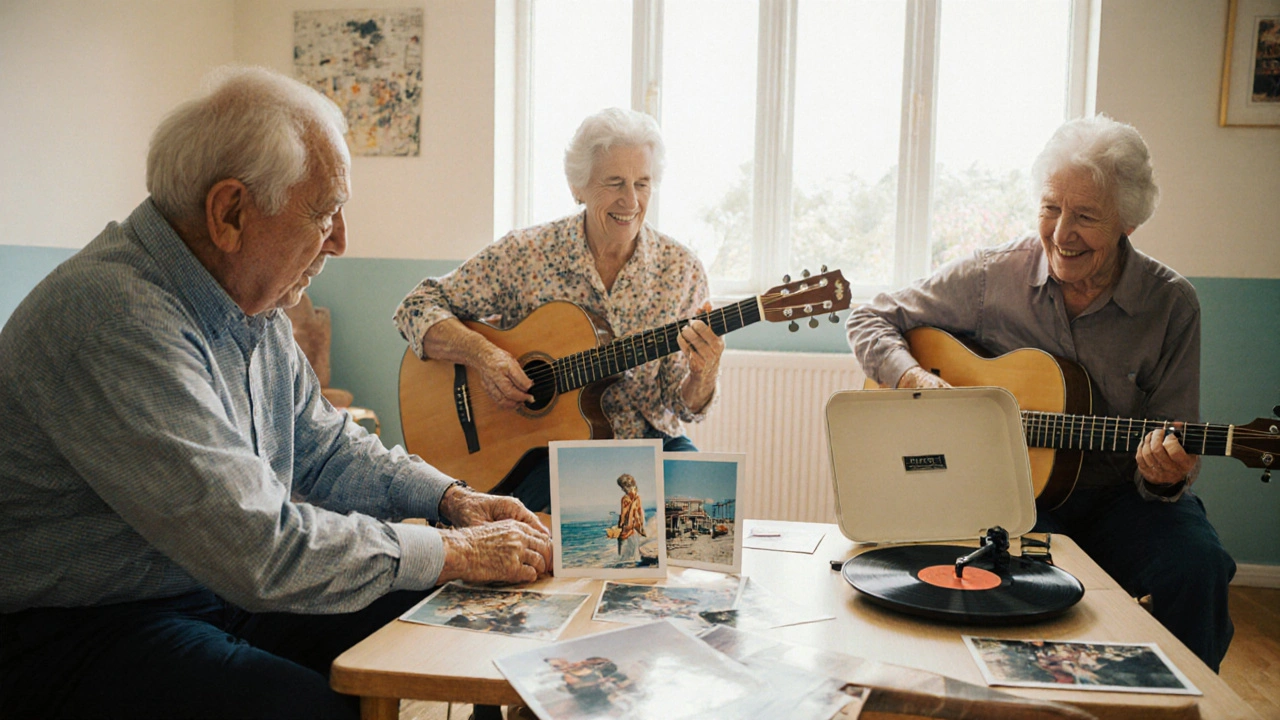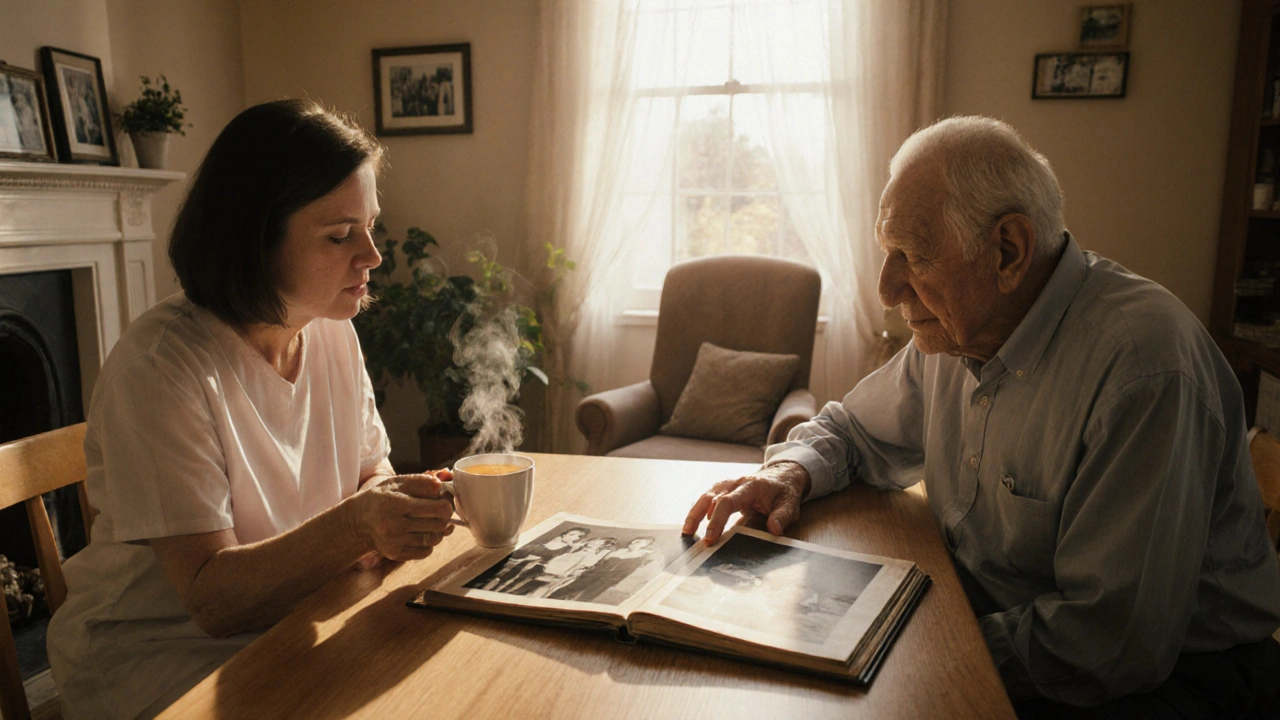Social Activity Planner for Alzheimer's Dementia
Your personalized social interaction plan will appear here after selecting an activity type and clicking "Generate My Social Plan".
Key Takeaways
- Social interaction stimulates brain networks that slow cognitive decline in Alzheimer's dementia.
- Evidence shows group activities, reminiscence, and music therapy improve mood and reduce caregiver stress.
- A simple plan-daily conversation, weekly outings, and monthly themed groups-can be built by anyone caring for a person with Alzheimer’s.
- Measuring impact through simple mood logs and functional check‑lists helps fine‑tune the program.
- Avoid overstimulation; tailor activities to the person’s history, abilities, and preferences.
When it comes to living with Alzheimer's dementia, the medical side gets most of the headlines-meds, diagnostics, and brain scans. Yet, a growing body of research shows that the everyday moments of chatting over tea, humming a favorite song, or sharing old photos can be just as powerful. This article walks you through why social interaction matters, which activities work best, and how to turn good intentions into a concrete, low‑stress routine for both the person with dementia and the caregiver.
What Is Alzheimer’s Dementia?
Alzheimer’s dementia is a progressive neurodegenerative disorder that primarily impairs memory, thinking, and behavior. First described by Dr. Alois Alzheimer in 1906, the disease is characterized by the buildup of amyloid plaques and tau tangles in the brain, which disrupt neural communication and lead to cell death. In New Zealand, about 1 in 10 people over 85 are living with the condition, and the prevalence is rising globally as populations age.
Why Social Interaction Helps
Social engagement isn’t just a feel‑good perk; it triggers measurable changes in the brain. Studies using functional MRI have shown that meaningful conversation activates the prefrontal cortex, hippocampus, and default mode network-areas that are among the first to deteriorate in Alzheimer’s. This activation promotes neuroplasticity, the brain’s ability to form new connections, which can temporarily offset loss of function.
Beyond the biology, social interaction satisfies basic human needs for belonging and purpose. When a person with Alzheimer’s feels connected, anxiety and agitation drop, sleep improves, and appetite steadies. For caregivers, shared activities provide moments of joy that break the monotony of daily care, reducing burnout and improving overall family dynamics.
Evidence‑Backed Benefits
Three major research streams back up the anecdotal stories:
- Reduced Neuropsychiatric Symptoms: A 2022 meta‑analysis of 31 trials found that regular group interaction lowered scores on the Neuropsychiatric Inventory by an average of 3.2 points, indicating less agitation, depression, and wandering.
- Slower Cognitive Decline: In a two‑year longitudinal study of 250 participants, those who engaged in ≥3 hours of structured social activity per week declined 20% slower on the Mini‑Mental State Examination (MMSE) compared with a control group.
- Improved Quality of Life: The Dementia Quality of Life (DEMQOL) questionnaire showed a 7‑point rise in the social‑interaction arm of a multi‑center trial, translating to better perceived wellbeing for both patients and caregivers.
Types of Social Activities That Work
Not every social setting is created equal. Below are five proven formats, each with a brief “how‑to” starter.
Reminiscence Therapy
Reminiscence therapy is a structured activity where participants recall personal memories using photos, music, or familiar objects. The approach taps into long‑term memory, which often remains intact longer than short‑term recall.
- How to start: Gather a box of 10‑15 photos from the person’s youth (school, family events, travel). Set a weekly 30‑minute “memory hour” where you ask open‑ended questions like, “What do you remember about that day?”
- Tip: Use physical photos rather than digital screens; the tactile element adds sensory input.
Music Therapy
Music therapy involves listening to or creating music that holds personal meaning. Rhythm and melody can bypass damaged language centers and directly engage emotion‑related brain regions.
- How to start: Compile a playlist of 20 songs from the person’s teenage years. Play quietly during morning routines or use a sing‑along session once a week.
- Tip: Encourage clapping or gentle percussion; the motor activity reinforces coordination.
Group Exercise
Group exercise combines physical movement with social contact, boosting blood flow to the brain and releasing endorphins that improve mood.
- How to start: Join a local “senior stretch” class or organize a simple chair‑based routine at home with a neighbor.
- Tip: Keep it low‑impact; the goal is consistency, not intensity.
Community Outings
Community outings encompass trips to parks, markets, or faith‑based gatherings. Familiar environments reduce confusion, while the novelty of new sights adds stimulation.
- How to start: Schedule a short walk to a nearby garden twice a week. Bring a favorite hat or scarf to provide a sense of comfort.
- Tip: Choose times when the venue is less crowded to avoid sensory overload.
Digital Social Platforms
Video calls, simple tablet games, or virtual reality tours can connect a person with distant family members. While technology can be intimidating, guided sessions with a caregiver turn it into a bonding experience.
- How to start: Set up a weekly 15‑minute Zoom call with a grandchild. Use a tablet on a stand to keep hands free.
- Tip: Keep the interface uncluttered; large icons and audio cues work best.

Building a Social Interaction Plan
Creating a routine doesn’t require a professional therapist-just a few minutes of planning each week. Follow these five steps:
- Assess Preferences: Talk with the person (or review past hobbies) to list favorite music, past occupations, and social comfort levels.
- Set Frequency Goals: Aim for at least three 30‑minute sessions per week, mixing one high‑energy activity (like group exercise) with two low‑key activities (talking, reminiscence).
- Gather Materials: Assemble photo albums, music playlists, a sturdy chair for exercises, and a simple calendar to track sessions.
- Assign Roles: If multiple caregivers are involved, designate who leads each activity. Consistency helps the person know what to expect.
- Review and Adjust: Every month, use a quick mood log (smile, neutral, frown) and a functional checklist (e.g., ability to follow a story) to see what’s working.
The plan should be flexible; the goal is to keep social contact enjoyable, not to add stress.
Common Pitfalls and How to Avoid Them
Even well‑intentioned programs can backfire if they ignore the person’s limits.
- Overstimulation: Too many people or loud environments can trigger agitation. Keep groups small (2‑4 participants) and limit background noise.
- One‑Size‑Fits‑All Activities: Not every person enjoys the same games. Offer choices-if music isn’t appealing, try storytelling.
- Neglecting Caregiver Rest: Caregivers need breaks. Schedule alternating days where another family member or a respite service steps in.
- Missing Follow‑Through: Sporadic sessions lose impact. Use calendar reminders on phones or sticky notes on the fridge.
Measuring Impact
To know whether the effort is paying off, adopt two simple tools:
- Mood Log: After each activity, rate the person’s affect on a three‑point scale (happy, neutral, upset). Over a month, look for an upward trend.
- Functional Checklist: Track basic tasks-following a two‑step instruction, naming a familiar object, or walking a short distance. Note any improvements or stability.
When you see positive shifts, reinforce those activities. If scores dip, consider shortening sessions or switching to a calmer format.
Putting It All Together: A Sample Week
| Day | Activity | Duration | Goal |
|---|---|---|---|
| Monday | Reminiscence session (photo album) | 30min | Stimulate long‑term memory |
| Tuesday | Group chair exercise | 20min | Improve circulation and mood |
| Wednesday | Phone call with grandchild (video) | 15min | Maintain family bonds |
| Thursday | Music therapy (playlist) | 30min | Reduce anxiety, evoke emotions |
| Friday | Community garden walk | 30min | Provide sensory variety |
| Saturday | Free conversation over tea | 20min | Foster connection |
| Sunday | Rest / open day | - | Prevent fatigue |
Adjust the schedule as needed-maybe swap Thursday’s music for a movie night if the person enjoys films.
Where to Find Support in Wellington
Local councils run weekly “Memory Café” meet‑ups where caregivers and people with dementia share tea and activities. The Alzheimer’s NewZealand branch offers a helpline (0800690690) for advice on structuring social programs. If transportation is a barrier, many community volunteer groups provide free rides to outings.
Frequently Asked Questions
Can social interaction replace medication?
No. Social activities complement, but do not substitute, approved medicines. They can lower the dose needed for some symptoms, but always discuss changes with a doctor.
How much social activity is enough?
Research points to at least three 30‑minute sessions per week, mixing mental and physical interaction. The exact amount varies with each person’s stamina.
What if the person becomes agitated during an activity?
Stop the activity, give a calm break, and note what triggered the reaction. Often, reducing noise levels, shortening the session, or switching to a familiar task helps.
Are there risks with digital social platforms?
The main risk is confusion from too‑fast visual changes. Use simple, large‑icon apps, limit session length, and stay beside the person to guide them.
How can I involve other family members?
Create a shared calendar (Google or printed) that lists who leads each activity. Rotate responsibilities so no one feels overloaded.
Social interaction isn’t a magic cure, but it’s a proven, low‑cost tool that can make daily life brighter for people living with Alzheimer’s dementia and the loved ones who care for them. Start small, stay consistent, and watch the subtle changes add up to a richer, more connected experience.

Angel Gallegos
October 2, 2025 AT 22:27